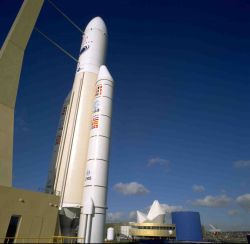China, Russia and other adversaries including Iran and North Korea pose a threat to U.S. infrastructure on the ground and in space according to a new congressional report, a conclusion that may sharpen lawmakers’ focus on building a recently mandated backup system for GPS timing,
The Worldwide Threat Assessment, released Wednesday by the Senate Select Committee on Intelligence, says that all four nations plus criminal organizations have the ability to use cyber techniques to create local disruptions of critical infrastructure.
Though the report did not specifically mention GPS jamming or spoofing, these kinds of disruptions are considered to be a form of cyberattack — and something all four nations have already been accused of doing outside the United States. China has reportedly used GPS jamming to thwart surveillance of its activities in the disputed Spratly Islands. North Korea’s jamming of GPS signals in 2012 impacted hundreds of flights using Seoul’s Incheon airport, according to a Heritage Foundation report, and Iran used GPS spoofing to help it capture a drone in 2011 in northeastern Iran.
Russia has jammed GPS signals in conflict zones and is also reportedly suspected of jamming signals in Norway. In addition, “Moscow is now staging cyberattack assets to allow it to disrupt or damage U.S. civilian and military infrastructure during a crisis,” the report said.
According to the committee the space-faring nations of China and Russia also have, or will soon have, the ability to take out satellites — including, eventually, satellites at higher orbits like those comprising the GPS constellation.
The loss of the GPS signal is potentially crippling to segments of U.S. critical infrastructure that rely on precise GPS timing to synchronize data flows, time stamps and other things like the transmission of electricity. To address this risk Congress mandated in December the creation of a national backup system for GPS timing in the National Timing Resilience and Security Act of 2018. The new law gives the Department of Transportation (DOT) until 2020 to establish such a system.
Dana Goward, president of the Resilient Navigation & Timing Foundation and an advocate of building a terrestrial backup, believes Congress will go further in the new session, perhaps providing money for the project and expanding what they want it to do.
His hopes for a more capable backup are based on “a very straight arrow of (congressional) intent,” Goward told attendees at the Institute of Navigation’s ITM/PTTI meeting in Reston, Virginia this week.
Several years ago, he said, there was a lot of concern in Congress’ defense committees and questions and demands for reports about what the Department of Defense was going to do to ensure national security should space assets become unavailable.
“There was then a requirement for a report on requirements for a PNT (position, navigation and timing) backup system,” Goward said. “Then there was a requirement for a plan to do a demonstration of a PNT backup system. Then there was funding in one year for the demonstration of a PNT backup system. The following year authorization language included affirmation of Congress’ continued interest in the demonstration system and a PNT backup system. Subsequently additional funds were appropriated for the demonstration.”
The effort culminated in Congress directing DOT to build a backup timing system. “So it seems to us there are a number of next logical steps including expanding the timing requirement into a navigation piece and also providing some funding to the demand for the timing system,” Goward added.
With the democrats now the majority in the House,Peter DeFazio (D-Oregon), who sponsored the bill in the House, will be chairman of the House Transportation and Infrastructure Committee and in a better position to ensure the backup gets built. Helping him is the fact that other advocates including SenatorsEd Markey (D-Massachusetts) and Ted Cruz (R-Texas) have returned to Washington as has the Act’s strongest supporter, Rep. John Garamendi (D-California).
“I can tell you that. Mr. Garamendi, as you may know, is pretty much the most driving force behind this,” said Goward, “although it’s a very bipartisan effort in both the House and the Senate. In the Senate Sen. Markey, who is very, very progressive and Sen. Cruz, who is very, very conservative, came together to push the issue through in the Senate. That is one example of how much broad support this has. Mr. Garamendi is now (in) the majority in the House and is even better positioned to influence this going forward. So we are optimistic that this will continue to get attention.”






